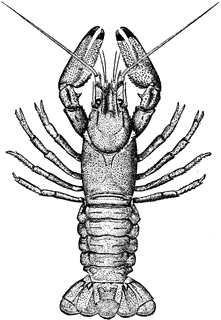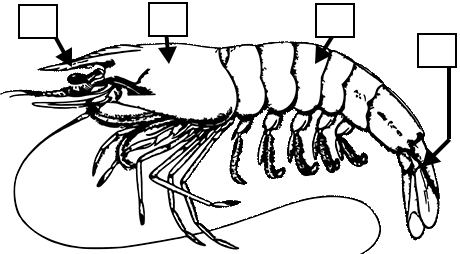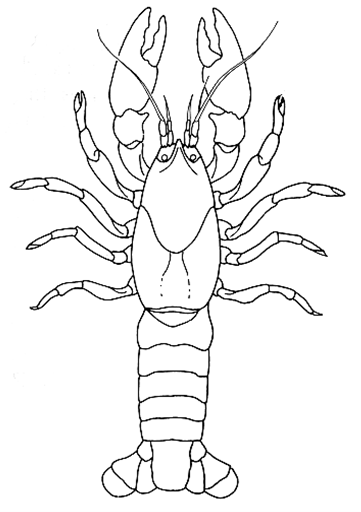The External Anatomy of the Crayfish

Crayfish are freshwater crustaceans that belong to the Phylum Arthropoda (subphylum Crustacea). They are also known as crawfish, crawdads, and mudbugs. They can be found in freshwater streams or even in muddy ditches. They are decapods, meaning that they have five pairs of appendages and are related to crabs, shrimp, and lobsters.
They have three distinct body regions: the head, thorax, and abdomen. The head and thorax are fused to form the cephalothorax. In this activity, you will examine the external anatomy of a freshwater crayfish.
Pre Lab Questions:
1. What are the three body regions of a crayfish?
2. What is a decapod?
3. What animals are related to the crayfish?
The Head
Place the crayfish ventral side up so the mouthparts can be observed.
Label the diagram as you locate structures using the abbreviations.
4. Locate the mandible, which are the jaws of the crayfish. Unlike mammals, these jaws move side to side. This structure should be hard and difficult to move.
5. The crayfish has three mouth appendages used for manipulating food, the maxillipeds. The largest of them is the 3rd maxilliped . The 2nd maxilliped is shorter and lies next to the 3rd.
The 1st maxilliped is located closest to the mandible.
6. Locate the two large antennae and the smaller antennules that branch from the base. The antennae are sense organs (touch, taste, equilibrium)
7. Flip the specimen to its dorsal side to locate the eyes, which extend from two stalks called pedicles.
Mandible (M) 1st Maxilliped (1) 2nd Maxilliped (2)
3rd Maxilliped (3) Antenna (A1) Antennule (A2)
The Body
Label the diagram as you locate structures using the abbreviations.
8. The head and thorax of the crayfish are fused into a single structure called: the cephalothorax.
9. The cephalothorax is covered by a thick armor called a carapace. Extending from the carapace is a pointy structure called the rostrum
10..The abdomen of the crayfish is segmented and flexible. Bend the abdomen back and forth and observe how each segment moves.
Do they move independently? _____
11. Count the number of segments on the abdomen. Hint: bending it will show you where the segments are separated. How many segments are on your crayfish? ______
Compare this number to other crayfish, are they all the same? _________
The Appendages
13. Locate the chelipeds (the claws) which are used for defense and catching prey. Manipulate the cheliped to determine the direction in which the appendage can bend.
How many joints are there on a single cheliped?______
14. Cut the end of the cheliped off and use the forceps to find the connective tissue inside. Pulling on this tissue will make the claw open and close. Try it!
15. Behind the cheliped are four pairs of walking legs. Crayfish use these legs for crawling in water or on land.
How many joints are on each leg? _____
16. Locate the swimmerets (appendages attached to each segment of the abdomen). These appendages are for steering and maneuvering while swimming.
Are the swimmerets jointed? ______
How many pairs of swimmerets are there? ______
17. What are each of the following appendages specialized for?
Chelipeds: _________________________________________________
Walking Legs: _____________________________________________
Swimmerets : _______________________________________________
Determining the Sex of Your Crayfish
18. Look at the first pair of swimmerets on your crayfish. If these swimmerets are considerably larger and stiffer than the other swimmerets, you have a male. If the first swimmerets are about the same size as the others, your crayfish is a female. What is the sex of your crayfish? ____
19. Measure the length of your crayfish and compare it to other crayfish in the room to complete the table.
|
Female Crayfish
(length in cm)
|
Male Crayfish
(length in cm)
|
| Average: | Average: |
Based upon your data, which sex of crayfish is the largest? _______________
20. Color the crayfish.
For each structure, highlight the name and color it on the crayfish the same color.
![]() Cheliped
Cheliped ![]() Walking legs
Walking legs
![]() Antenna
Antenna ![]() Antennule
Antennule
![]() Eyes
Eyes ![]() Telson
Telson ![]() Uropod
Uropod
![]() Carapace
Carapace ![]() Abdomen
Abdomen
Related Resources
Anatomy of a Crayfish Virtual Lab
Crayfish Labeling – simple diagram with word bank
Arthropod Coloring – compares anatomy of crustaceans, spiders, and insects


